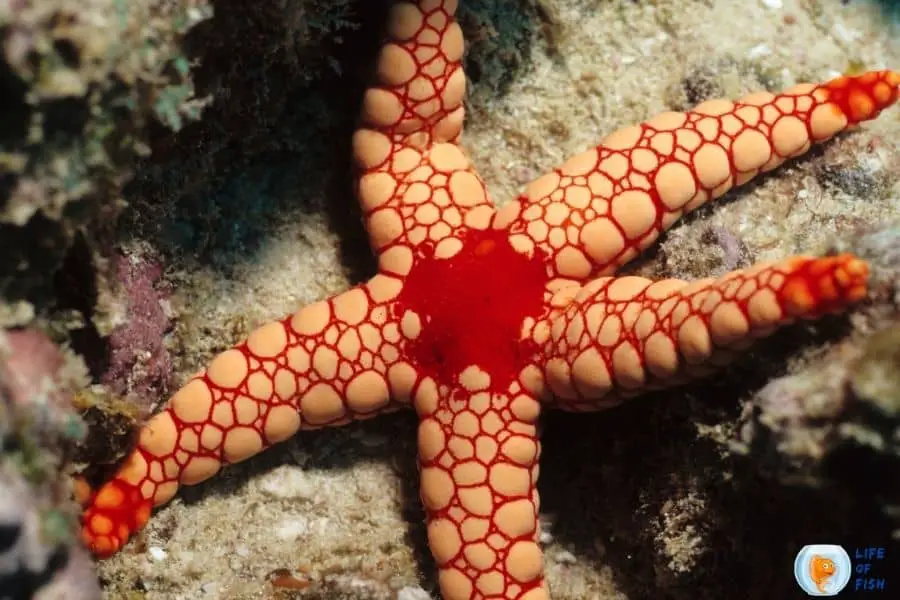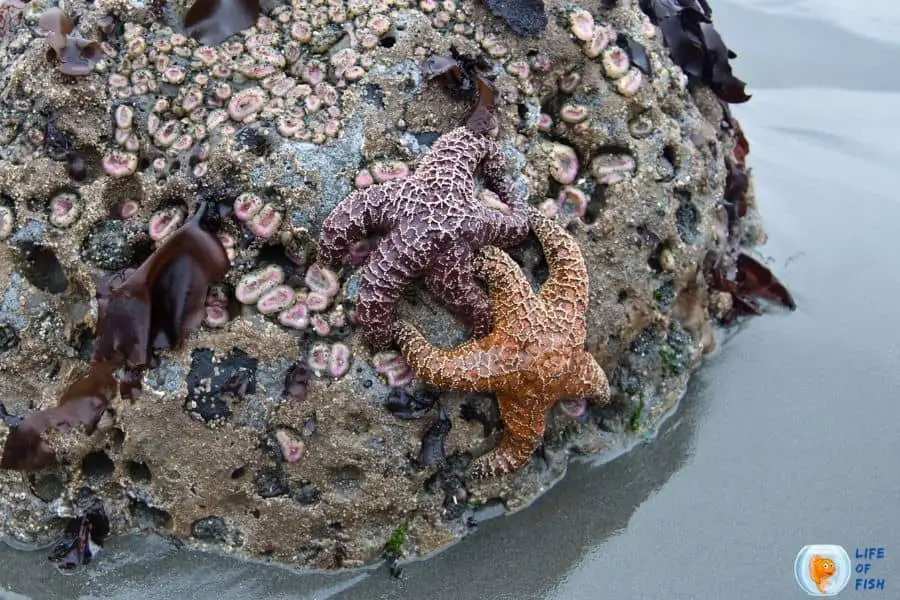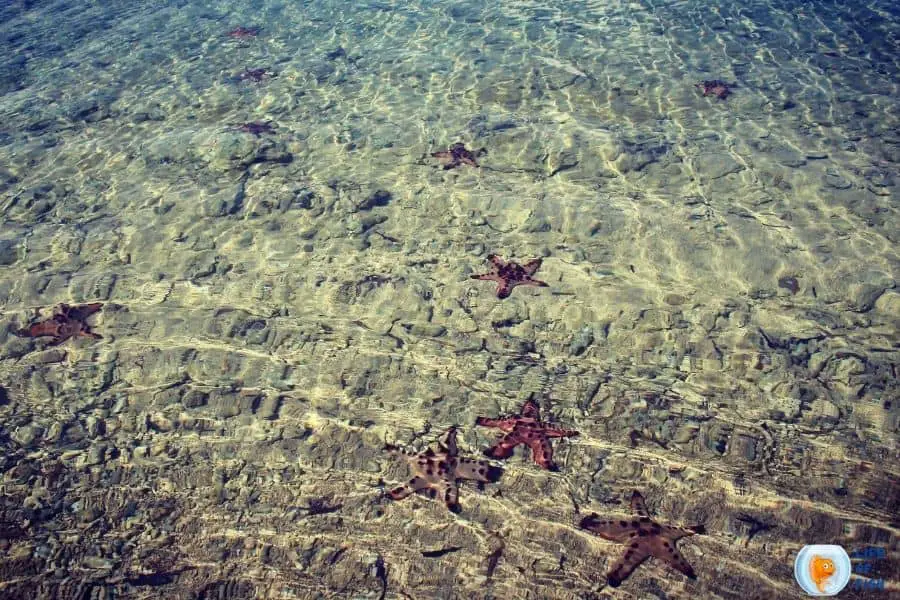Do you believe there are stars in both the sky and ocean? But the stars in the sea are different from the stars in the sky. The stars in the sea are named starfish, and in this article, we are going to find out how starfish reproduce.

Do Starfish Need A Mate To Reproduce?
Jump To
- 1 Do Starfish Need A Mate To Reproduce?
- 2 How To Identify Male And Female Starfish?
- 3 Asexual reproduction of sea stars?
- 4 Sexual reproduction of sea stars
- 5 Do Starfish Reproduce By Fragmentation?
- 6 Do Starfish Reproduce By Regeneration?
- 7 How Long Does It Take For A Starfish To Reproduce?
- 8 Do Starfish Lay Eggs Or Babies?
- 9 How Many Offspring Do Starfish Reproduce?
- 10 What Time Of Year Does Starfish Reproduce?
- 11 Do Starfish Have A Mate For Life?
- 12 How Ochre Sea Stars Reproduce?
- 13 How Brittle Starfish Reproduce?
- 14 Conclusion
Simply the answer is no. Starfish can reproduce without a mate. It means they can reproduce asexually. However, starfish is a resourceful creature. It means they can multiply their population in more than one way. Similarly, like other animals, they can reproduce by spawning together or mating. If not, starfish can asexually reproduce their offspring. However, asexual reproduction is not a better way to produce a new starfish in captivity. Because it cannot promote the genetic diversity within starfish species. Hence, the sexual method is the best to reproduce starfish to enhance genetic diversity.

How To Identify Male And Female Starfish?
Typically, most of the animals in the world are born as a male or female. But when it’s come to starfish, it is pretty complex. Starfish have distinct gender so that they can mate with other starfish, but it is difficult to distinguish their gender by physical appearance. But male-like Archaster typicus is smaller than females. Other starfish species do not have visible features to identify their gender. However, there is a physiological difference between male and female starfish. But to see it, you must have a microscope.
The general rule is females produce eggs while males produce sperms. So, their gonad structure should differ from each other. In addition to that, female and male starfish are different in their reproductive organs. But typically, these organs are small and situated inside of the body. Therefore, if you look at starfish underside by flipping, it isn’t easy to distinguish their gender clearly.
Related: Sea bunny | Super Interesting Facts You Must Know
Asexual reproduction of sea stars?
To produce starfish asexually, you have to remove the starfish’s arms along with its part of the central disk. This separate piece can form a whole starfish. In other words, you can reproduce starfish asexually by fission or through the autonomy of arms. In fission, the starfish’s central disk is broken into two parts, and each piece regenerates its missing parts to be a complete starfish.
When it’s come to autotomy, the starfish sheds with the part of the central disk. Then it lives like a “comet” independently. Over time, it will grow the set of the arms of starfish. But you make sure your starfish species can reproduce via this method. Because even though most starfish can regenerate their limbs, few species can breed in these ways.
Sexual reproduction of sea stars
Sexually reproduction occurs when the conditions are right. At this right time, starfish start to mate sexually. They spawn. It means starfish release their sex cells into the water. Simply female starfish release eggs, and male starfish release sperms to fertilize the eggs. Then over time, fertilized eggs hatch and produce swimming larvae. They are floating in the water and grow up.
Also, this reproducing process occurs as a group called spawning aggregation. Also, it enhances the opportunities for eggs and sperms to find each other. However, according to the starfish species, mating strategies can be varied. In this case, we cannot see any pregnancy signs. Because embryos form and develop in the seawater.
Thus, most of the starfish can be recognized as oviparous. Because embryos form and develop externally. However, there is an exception to this. Some starfish develop within the gonads of their parents. A suitable example is Patiriella vivipara. However, they leave their parents after developing their five arms. After that period, they have the ability to live independently.

Do Starfish Reproduce By Fragmentation?
Yes, sea stars or starfish can reproduce via fragmentation. Fragmentation can be defined as breaking the body into two parts and regenerating each to produce two individuals. Here the large arm of the starfish fragments as another starfish and regenerates its missing parts.
Do Starfish Reproduce By Regeneration?
Simply, yes, starfish can reproduce by regeneration. But the answer depends on the starfish species that you have. Most starfish species can regenerate their limbs. But among them, only some species can reproduce by fragment or fission and regenerate. Therefore, you should be highly aware of the starfish species that you have. Another essential thing is breeding methods can be varied from species to species.
How Long Does It Take For A Starfish To Reproduce?
Generally, when starfish are two years old, they become an adult. So, from this age, they can reproduce.
Do Starfish Lay Eggs Or Babies?
Starfish lay eggs, not babies. When the conditions are right, starfish start to spawn by releasing sperms and eggs into the water.
How Many Offspring Do Starfish Reproduce?
Female starfish can lay up to 65 eggs at once. But we cannot say all these eggs make starfish babies. Because eggs should fertilize to produce successful offspring. Other than that, these eggs can be prey to predators like fish, snails, crabs, otters, and birds. So, the offspring amount highly depends on the environmental force.
What Time Of Year Does Starfish Reproduce?
Generally, starfish reproduce sexually in late winter and spring. On the other hand, they reproduce new starfish by asexually or fission at other times of the year. Most probably in summer.
Do Starfish Have A Mate For Life?
No, Typically, sea stars tend to reproduce either sexually or asexually as a group.
How Ochre Sea Stars Reproduce?
Ochre sea star reproduces sexually or asexually. Also, they are dioecious. However, this starfish species do not have sexual dimorphism. Their sex can be distinguished only by examining their sex organs. It means that the presence of sperms or eggs in their gonads. Generally, it has the ability to reproduce at the age of five.
Further, ochre sea star or starfish reproduces new starfish by broadcast spawning. It means that after fertilizing the eggs of this starfish, larvae or baby starfish float on the surface of the ocean. Also, they feed on zooplankton for a few weeks until baby starfish’s metamorphosis and turns into the little version of starfish.

How Brittle Starfish Reproduce?
Generally, most of the brittle star species reproduce by spawning. Female stars release eggs, and males release sperms onto fertilize eggs. Then after a few days, larvae are released by hatching the fertilized eggs. However, some brittle species produce their generation by fission while some are producing sexually. Moreover, some brittle stars have the ability to breed asexually in two ways. The first one is they break one or more arms with a portion of the central body. Then these broken pieces regenerate missing parts with arms to create a whole new brittle star.
The second way is, brittle star juveniles can create a new starfish during their settling stage. After complete the metamorphosis, larvae lose the last two arms. Also, the important thing is the special tissue at the attachment point, creating a new ophioplutei. And it swims off to develop into starfish.
Conclusion
Starfish is a beautiful creation, and it is not a fish at all. However, not only other marine animals, starfish, or sea stars can reproduce sexually and asexually. Further, there are male and female starfish, but it isn’t easy to distinguish through their physical appearance. However, starfish can create new starfish through spawning and fission, while some starfish breed by spawning. Anyhow the reproducing methods can be varied with starfish species. Furthermore, they have to pass many stages to be a tiny sea stars that we love.
Read Next: Blind Cave Tetra | 15 Things You Probably Didn’t Know About |
